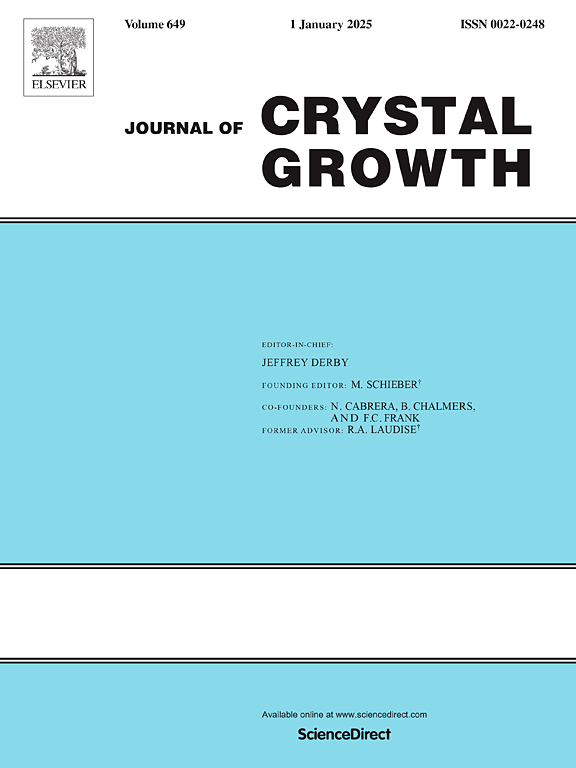优选取向六方锌矿纳米晶体的x射线衍射研究:晶体学研究
IF 1.7
4区 材料科学
Q3 CRYSTALLOGRAPHY
引用次数: 0
摘要
通过六水合硝酸锌和氢氧化铵在室温下合成的多功能纳米级、纯高晶ZnO(锌矿)倾向于形成晶格参数为a=b= 3.251 Å, c= 5.208 Å的六方纤锌矿结构;α=β= 90°,γ= 120°,Zn-O键长为1.9785 Å。采用不同的晶体学参数和几种相同的模型对晶体尺寸、晶格应变、应力和密度进行了分析。特定的加工条件更倾向于向(1 0 1)方向生长,这可能会影响电子、光学和功能性质。Rietveld细化表明,合成的材料完全由100%的锌矿相组成。透射电镜(TEM)分析表明,界面纳米晶体分布均匀,形态纯净,具有多面体形态的统一贡献。锌矿的TEM直方图显示出纳米级的颗粒分布,平均尺寸约为48.39 nm。选择区域电子衍射(SAED)模式分析证实,锌矿晶体取向性强,主要沿(0 0 2)平面,d-间距为0.2577 nm,具有高度结晶性和有序的晶格结构。计算出原子质量组成为81% Zn和19% O,确定了统一的晶体结构。振动样品磁强计(VSM)分析表明,合成的氧化锌纳米晶体具有顺磁性。x射线光电子能谱(XPS)分析发现,锌2p3/2的结合能为1022.19 eV,表明纤锌矿(ZnO)结构中存在Zn2+。本文章由计算机程序翻译,如有差异,请以英文原文为准。
X-ray line diffraction study of preferred oriented hexagonal zincite nanocrystals: A crystallographic investigation
Multifunctional nanoscale, pure and high crystalline ZnO (Zincite) at room temperature synthesis through zinc nitrate hexahydrate and ammonium hydroxide prefers to develop hexagonal wurtzite structure consisting of lattice parameters a=b= 3.251 Å, c= 5.208 Å; α=β= 90°, γ= 120° with a Zn-O bond length of 1.9785 Å. Different crystallographic parameter calculated and several identical models were employed to analyze crystallite sizes, lattice strain, stress and density. The specific processing condition prefers to grow in direction of (1 0 1), which may influence electronic, optical and functional properties. The Rietveld refinement revealed that synthesized material consists entirely of 100 % Zincite phase. Transmission electron microscope (TEM) analysis revealed a homogeneous distribution of interface nanocrystals, indicating the nanocrystals were in pure form and exhibited a unified contribution with polyhedral morphology. TEM histogram of Zincite showed a nanoscale particle distribution with an average size of approximately 48.39 nm. Selected area electron diffraction (SAED) pattern analysis confirmed that Zincite crystals were highly oriented, predominantly along the (0 0 2) plane, with d-spacing of 0.2577 nm, indicating a highly crystalline and well-ordered lattice structure. The atomic mass composition was calculated to be 81 % Zn and 19 % O, confirming a unified crystal structure. Vibrating sample magnetometer (VSM) analysis revealed that the synthesized Zincite nanocrystals exhibited paramagnetic behavior. X-ray photoelectron spectrometer (XPS) analysis explored characteristic Zn 2p peaks, with Zn 2p3/2 at a binding energy of 1022.19 eV, indicating the presence of Zn2+ in wurtzite (ZnO) structure.
求助全文
通过发布文献求助,成功后即可免费获取论文全文。
去求助
来源期刊

Journal of Crystal Growth
化学-晶体学
CiteScore
3.60
自引率
11.10%
发文量
373
审稿时长
65 days
期刊介绍:
The journal offers a common reference and publication source for workers engaged in research on the experimental and theoretical aspects of crystal growth and its applications, e.g. in devices. Experimental and theoretical contributions are published in the following fields: theory of nucleation and growth, molecular kinetics and transport phenomena, crystallization in viscous media such as polymers and glasses; crystal growth of metals, minerals, semiconductors, superconductors, magnetics, inorganic, organic and biological substances in bulk or as thin films; molecular beam epitaxy, chemical vapor deposition, growth of III-V and II-VI and other semiconductors; characterization of single crystals by physical and chemical methods; apparatus, instrumentation and techniques for crystal growth, and purification methods; multilayer heterostructures and their characterisation with an emphasis on crystal growth and epitaxial aspects of electronic materials. A special feature of the journal is the periodic inclusion of proceedings of symposia and conferences on relevant aspects of crystal growth.
 求助内容:
求助内容: 应助结果提醒方式:
应助结果提醒方式:


